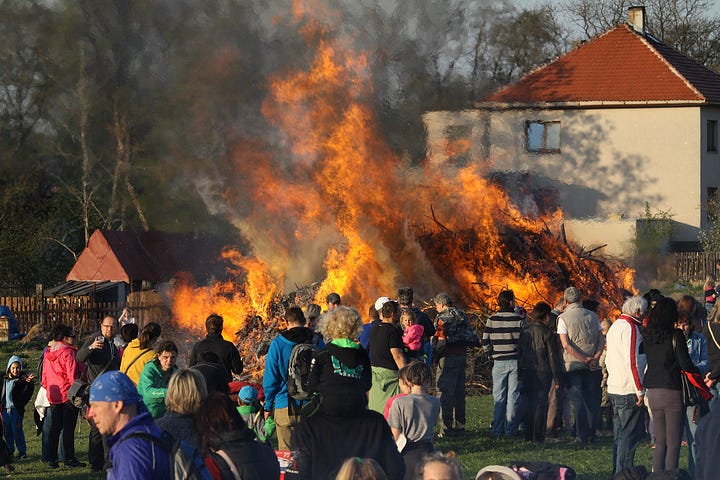Halloween is an increasingly popular celebration in the southern hemisphere with spooky costumes, Halloween-themed decorations, and trick-or-treating supplies emerging in stores from September. Celebrating Halloween at this time of year is seasonally appropriate for the northern hemisphere. Modern Halloween celebrations evolved from the ancient Celtic celebration of Samhain, the mid-point between the autumn equinox and the winter solstice, marking the end of the harvest, and the coming of winter. Halloween icons such as the Harvest Moon, pumpkins, apples, black cats and spooky decorations and costumes reflect a profoundly autumnal theme.
However, in the southern hemisphere, the 31st of October occurs between the spring equinox and the summer solstice. At this time of year, the southern hemisphere is actually celebrating Beltane, which marks the end of winter and the start of summer according to the Celtic and Germanic calendars. It was believed that the veil between the ‘real’ world and the world of magic (Fae/Sidhe/Ao si) was thinnest at this time of year, even more so than during Samhain.
Beltane was and is still celebrated across Europe in the Celtic, Germanic, Scandinavian, Romani and Slavic cultures, with similar traditions albeit different names. These traditions include balefires (bonfires), dancing around a Maypole, going ‘a-Maying,’ picnics in forests or meadows, bathing in dew, visiting natural springs, cutting a May bush, making flower wreaths and other traditions that celebrate spring, fertility, sexuality and the blossoming of life.
Over the next four weeks, in the lead-up to Beltane, we will explore different aspects of Beltane celebrations, traditions and folklore as well as similar and equally colourful festivities of the Germanic Walpurgisnacht (Walpurgis Night) and the Latin American Día de los Muertos (Day of the Dead).
Air - Beltane vs Halloween, and Walpurgis Night (October 3 - today)
Fire - The Sacred Balefires (October 10)
Water - Springs, Wells, and Morning Dew (October 17)
Earth - Forest, Fields and Flowers (October 24)
Spirit - Day of the Dead (October 31)
Walpurgis Night
Walpurgis Night, also known as Walpurgisnacht or Hexennacht (Witches’ Night), is a traditional spring festival celebrated in parts of Northern and Central Europe, particularly in Germany, Sweden, Finland and the Czech Republic. The celebration takes place on the night of April 30th and continues into May 1st, marking the transition from winter to spring in a similar manner to the Celtic celebration of Beltane.

Walpurgis Night has its roots in both pagan and Christian traditions. It is named after Saint Walpurga, also known as Walburga or Valborg, an 8th-century English missionary who was canonized on May 1st 870 A.D. for her significant role in spreading Christianity throughout the region. She was born in Devon, England, and was the daughter of Saint Richard the Pilgrim. Walpurga studied medicine and travelled to what is now Germany, where she established a monastery in Heidenheim and became its abbess.


The connection between Saint Walpurga and witches is primarily due to the timing of her feast day, which falls on May 1st, coinciding with the celebration of Walpurgis Night. In European folklore, especially in Germany, Walpurgis Night is associated with witches, witchcraft, and other supernatural occurrences. This association is not because of anything Saint Walpurga did but rather because her feast day was already celebrated during a time when pagan traditions and superstitions relating to witches and the arrival of spring were prevalent.


In medieval and early modern Europe, people believed that on the night of April 30th, witches and other supernatural beings would gather on the Brocken, the highest peak of the Harz mountains in Germany, to hold wild revelries and engage in various magic rituals. People would light bonfires, make noise, and dress in costumes and masks to ward off the supposed malevolent forces associated with the night. Over time, Saint Walpurga's feast day became intertwined with these pagan and folk traditions, and she came to be seen as a protector against witches and evil spirits.
Today, Walpurgis Night is celebrated with various festivities, including bonfires, music, dancing, and feasting. In Germany, it is a particularly popular celebration, with many towns and villages holding outdoor gatherings, often featuring live music performances and the burning of a symbolic witch effigy atop a bonfire. People also dress up in costumes and masks, continuing the tradition of warding off evil spirits.



The music video (3:48 mins) below by the German group Faun depicts many of the traditions we will explore in the next Beltane-themed articles.
Next week we will explore the history and traditions of the sacred Beltane ‘bale’ or bonfires. In the meantime, may you enjoy a blossom-filled week. In the meantime, may you enjoy a blossom-filled week and may your Beltane witches, as Arundhati Roys says “wear flowers in their hair and magic secrets in their eyes”!
See you next week for Episode 21 – Beltane (Fire): Lighting the Balefires.
















Share this post